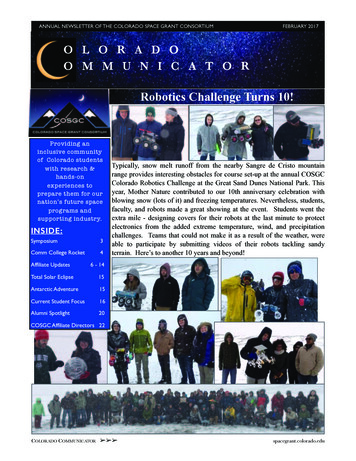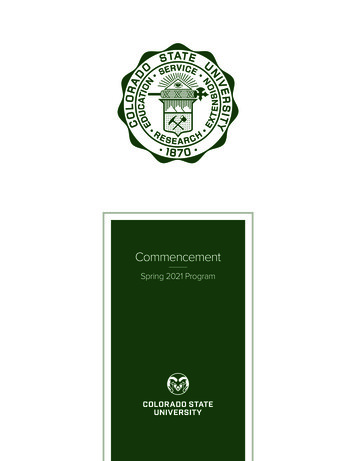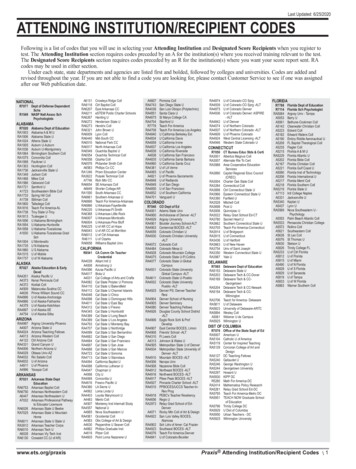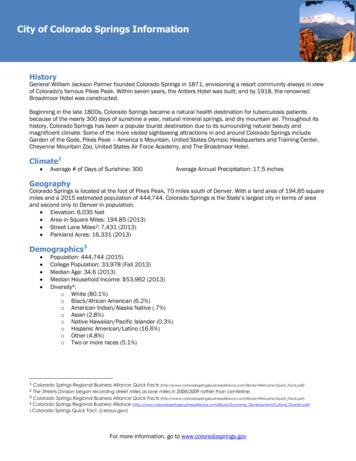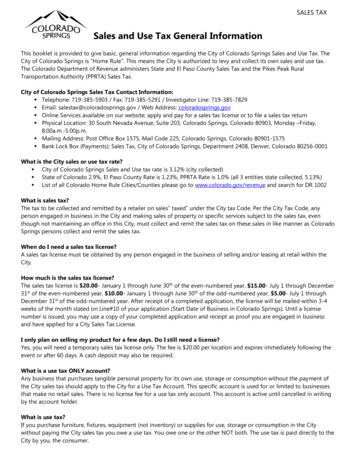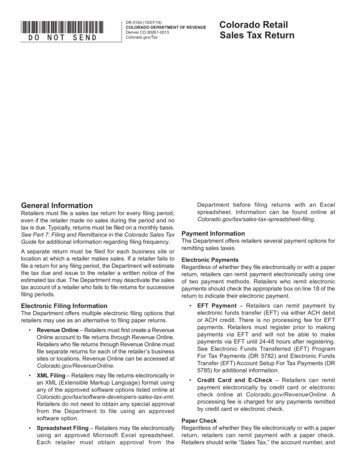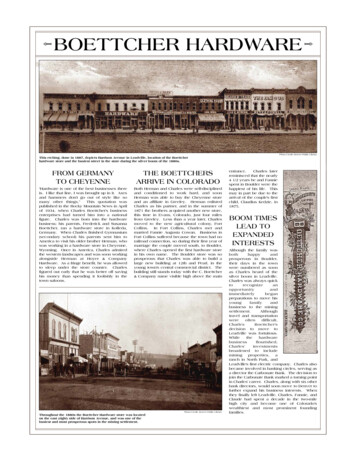
Transcription
BOETTCHER HARDWAREPhoto Credit: Denver Public LibraryThis etching, done in 1887, depicts Harrison Avenue in Leadville, location of the Boettcherhardware store and the busiest street in the state during the silver boom of the 1880s.FROM GERMANYTO CHEYENNETHE BOETTCHERSARRIVE IN COLORADO“Hardware is one of the best businesses thereis. I like that line, I was brought up in it. Axesand hammers don’t go out of style like somany other things.”This quotation waspublished in the Rocky Mountain News in Aprilof 1934, when Charles Boettcher’s businessenterprises had turned him into a nationalfigure. Charles was born into the hardwarebusiness; his parents, Frederick and SusannaBoettcher, ran a hardware store in Kolleda,Germany. When Charles finished Gymnasium(secondary school) his parents sent him toAmerica to visit his older brother Herman, whowas working in a hardware store in Cheyenne,Wyoming. Once in America, Charles admiredthe western landscapes and was soon workingalongside Herman at Hoyer & CompanyHardware. As a fringe benefit, he was allowedto sleep under the store counter. Charlesfigured out early that he was better off savinghis money than spending it foolishly in thetown saloons.Both Herman and Charles were self-disciplinedand conditioned to work hard, and soonHerman was able to buy the Cheyenne storeand an affiliate in Greeley. Herman enlistedCharles as his partner, and in the summer of1871 the brothers acquired another new store,this time in Evans, Colorado, just four milesfrom Greeley. Less than a year later, Charlesmoved to the new agricultural colony, FortCollins.In Fort Collins, Charles met andmarried Fannie Augusta Cowan. Business inFort Collins suffered because the town had norailroad connection, so during their first year ofmarriage the couple moved south, to Boulder,where Charles opened the first hardware storein his own name. The Boulder store was soprosperous that Charles was able to build alarge new building at 12th and Pearl, in theyoung town’s central commercial district. Thebuilding still stands today with the C. Boettcher& Company name visible high above the mainPhoto Credit: Denver Public LibraryThroughout the 1880s the Boettcher Hardware store was locatedon the east (right) side of Harrison Avenue, and was one of thebusiest and most prosperous spots in the mining settlement.entrance.Charles laterreminisced that the nearly4 1/2 years he and Fanniespent in Boulder were thehappiest of his life. Thismay in part be due to thearrival of the couple’s firstchild, Claudius Kedzie, in1875.BOOM TIMESLEAD TOEXPANDEDINTERESTSAlthough the family wasbothhappyandprosperous in Boulder,their days in the townwere numbered as soonas Charles heard of thesilver boom in Leadville.Charles was always eparations to move hisyoungfamilyandbusiness to the miningsettlement.Althoughtravel and ��sdecision to move toLeadville was les’investmentsbroadened to includeminingproperties,aranch in North Park, andLeadville’s first electric company. Charles alsobecame involved in banking circles, serving asa director the Carbonate Bank. The decision tojoin the Carbonate Bank marked a turning pointin Charles’ career. Charles, along with six otherbank directors, would soon move to Denver tofurther expand his business interests. Whenthey finally left Leadville, Charles, Fannie, andClaude had spent a decade in the two-milehigh city and become one of Colorado’swealthiest and most prominent foundingfamilies.
GREAT WESTERN SUGARDIVERSIFIEDINTERESTSPhoto Credit: Denver Public LibraryBy the end of the 1880s Charles Boettcherowned multiple hardware businesses and hadhis hand in mining, electricity, ranching, andbanking. In the 1890s his interests wouldgrow to include a meat packing company, arailroad, and Capitol Life Insurance. Charlesalso continued to build a banking empire whenhe became the President of the National Bankof Commerce in 1897. However, the financialpanic of 1893 and the rapid decline of silversignaled the end of Colorado’s boom periodand forced Charles to spend the next decadetrying to keep his businesses solvent. As aresult of these draining years, Charles andFannie took a six-month vacation to Europe.Before returning home, however, Charlesstudied Germany’s successful sugar beetindustry and obtained some high quality seed.Fannie then emptied one of her trunks totransport the seeds back to Colorado!A view of the Great Western Factory in Loveland, Colorado,one of the first factories built by Charles Boettcher and his associates.COLORADO’S FIRSTSUGAR FACTORYColorado’ s sugar beet industry had struggledto get off its feet for a number of years.Charles realized that Colorado’s farmersneeded to know more than how to grow beets;they needed to raise capital, to build factories,and to manufacture the sugar. Immediatelyupon his return, Charles enlisted JohnCampion, William Bryd Page, J.R. McKinnie,and his son, Claude, to form the Great WesternSugar Company. The group quickly developedplans to build a large factory in Loveland,south of Fort Collins. The plant’s first year wasa success, and soon other rural communitieswere willing to give sugar beets a chance.Charles’ ability to see sugar’s potential inColorado was crucial. Colorado’s economydepended on the development of newindustries, and the young state’s farmingcommunities were desperate for a profitablecrop. Between 1899 and 1900 the sugarindustry in Colorado grew from 100,000 to 3,600,000.Soon, factories were built inRocky Ford, Eaton, Greeley, Longmont, FortCollins, Windsor, and Holly.Photo Credit: Denver Public LibraryThe sugar beet industry provided work for laborersafter the decline of silver mining in the 1890s.WESTERNEXPANSIONBy 1905, Charles’ original partners had soldtheir stock to eastern interests. Charles,however, chose to join the directorate of thenew corporation. Over the next decades, thecompany expanded into Nebraska andWyoming and built additional factories inColorado at Brighton, Johnstown, and Ovid.By 1930, Great Western was one of the largestbeet sugar producers in the world. Betweenthe wars, Great Western employed 9,000people in twenty factories. By the late 1970s,Great Western produced almost 1/4 of thenation’s beet sugar.Charles Boettcher’sforesight and creativity in 1900 helped toensure economic stability for the entire statethroughout the 20th century, and led to thedevelopment of other lucrative enterprises.Photo Credit: Denver Public LibraryThe Great Western Factory in Sterling, Colorado circa 1910.
IDEAL CEMENTSUGAR BEETS LEAD TOCEMENT FACTORIESWhen Charles founded Great Western Sugar,Colorado was not truly industrialized. Most ofthe materials needed for industrialization hadto be imported from the East or from Europe,which was not only expensive but alsoinefficient.To Charles, the expense ofimporting high grade, durable cement seemedwasteful, and he instinctively knew thatColorado could produce its own. Coloradowas rich in the necessary natural resources,lime, silica, and alumina. In 1901, only monthsafter Great Western’s debut, Charles and JohnThatcher of Pueblo incorporated the PortlandCement Company and bought land adjacent toColorado’s only cement plant in Florence,Colorado. The owners of the existing plantrealized what they were up against and quicklyjoined forces with Boettcher and Thatcher.Just as he had with his hardware businesses,Charles made certain that his merchandisewas top-quality.Photo Credit: Denver Public LibraryThe sign at the Ideal Factory in Fremont County combines theoriginal Portland Cement name with the Ideal name, adopted in 1924.THE “IDEAL” INDUSTRYPhoto Credit: Denver Public LibraryPhoto Credit: Denver Public LibraryThe Ideal Cement Building, still located indowntown Denver, was the first reinforcedconcrete building in the city.Cris Dobbins began working for CharlesBoettcher at Ideal in 1919 as an office boy.He was named President of the company in1952 and served as chairman of the boardfrom 1968 until 1979.Photo Credit: Denver Public LibraryCharles Boettcher went to his office each morning in the Ideal Building.During his later years, Cris Dobbins picked him up at the Brown Palace,where he had an apartment, and dropped him off each evening.In 1908, Denver witnessed the completion ofits first reinforced concrete building at thecorner of Seventeenth and Champa, built byCharles Boettcher to promote the use ofcement. Charles even ordered the workers toburn the wooden forms used in construction todramatize the strength of cement. The buildingwould later be named the Ideal Building, as theconglomerate of cement companies gatheredby Charles Boettcher and his partners becamethe Ideal Cement Company in 1924, withCharles as President and Claude as VicePresident. A year later, a cement plant wascompleted outside Fort Collins, and the smalltown that resulted was named Boettcher,Colorado. After two decades of progress IdealCement had plants all over the West and thecement industry had led Charles and Claudeinto a variety of other industries, mostimportantly, potash. After Charles’ death, Idealmerged with Potash of America and becameIdeal Basic Industries.MEN OVER MACHINERYBy 1955, Ideal Cement employed 3,200people, operated 13 plants in 26 states, andwas one of the nation’s top three producingcompanies. Ideal Cement was not just a localbusiness -- it was a nationally recognizedtrademark and had achieved “a position ofprominence in the industry and nationally.”Ideal Cement became Charles’ primary focus,and it bore the stamp of his philosophy, whichincluded faith in his employees. As a result ofthis credo, Charles often promoted his trustedemployees to top positions. Chris Dobbins, forexample, began working as an office boy forCharles in 1919, and after decades ofdedicated service in a number of positions hewas named head of Ideal Cement. Charlesonce said, “There is nothing more important inany business than the men who make it up.Machinery can be bought or repaired, orrenewed, or rearranged, but the finestmachinery in the world is worthless withoutgood men to run it.”Charles’ employeescould never complain that he did not holdhimself to the same standards, as he went tohis office on the fifth floor of the Ideal Buildingnearly every day until his death at age 96.
BOETTCHER & COMPANYPIONEERS’ SONS TOFINANCE GROWTHAt the turn of the century, Denverites withcapital to spare realized that investing in thecity’s and the state’s future could bring bigdividends. Charles Boettcher and H.M. Porter,in addition to being close friends, werebusiness associates. They invested togetherand served on the board of directors ofColorado’s leading enterprises.In 1902,Boettcher and Porter set up the Fifteenth StreetInvestment Company to purchase and managedowntown Denver property. The Companybecame the largest landowner in downtownDenver. Encouraged by their fathers, ClaudeBoettcher and John Porter, along with anotherscion of the pioneer generation, GeraldHughes, further formalized their fathers’investment practices in 1910 when theyfounded Boettcher, Porter & Company. Thecompany’s first aim was to channel money intomuch-needed municipal projects and growingbusinesses. The company rapidly becameone of the region’s most successful firms.Tragically, John Porter died in 1925.Forseveral years, the firm operated under thename Boettcher & Company, and there werefew changes to the basic policies: expandalong conservative lines and finance westernenterprises.Photo Credit: Colorado Historical SocietyJohn Porter, co-founder ofBoettcher, Porter & Company.Photo Credit: Denver Public LibraryHenry M. Porter, close friend and associate ofCharles Boettcher and father of John Porter.The Moffat Tunnel was one of Boettcher & Company’s projects and wassignificant in opening Colorado’s western slope to commerce.Photo Credit: Colorado Historical SocietyClaude Boettcher at his desk in the Boston Building,with a portrait of his father who provided theinspiration for the investment company.Photo Credit: Denver Public LibraryThe Boston Building in downtown Denver, home ofBoettcher & Company for over sixty years.THE FIRMEVOLVESIn 1928, Claude’s only child Charles, along withJames Q. Newton, acquired a stock exchangefirm, which they renamed Boettcher, Newton &Company. The firm focused on commoditiesand securities, rather than municipals. Due toits similar name and 17th Street location, thetwo Boettcher partnerships were oftenconfused, and therefore decided to merge in1929 and to retain the Boettcher, Newton &Company name. The merged company washoused in the Boston Building on 17th Street,but before the files were even organized thestock market crashed.Creative measureswere needed to keep the company solventthrough the next decade. Claude Boettcherand James Newton led the company throughthis trying period. James was liberal andimpatient, while Claude was conservative andpragmatic.This blend helped keep thecompany grounded, while allowing it toprogress into the future. The controlled growthfacilitated by Boettcher, Newton & Co. helpedColorado to avoid some of the negativeconsequences of industrialization. The firmhelped to finance many historically significantprojects statewide, including the constructionof the Moffat Tunnel in 1924 and a new hangerPhoto Credit: Denver Public Libraryat the airfield, which eventually becameStapleton Airport. In 1938, James Newton andClaude handed the reigns over to WarrenWillard, who had been with the firm since1921. After Newton’s death in 1944 the firmbecame simply Boettcher & Company again.THE “WALL STREET”OF THE WESTUnder Willard’s leadership, Boettcher & Co.acquired a seat at the New York StockExchange, becoming the first Colorado firm todo so. Willard also instigated a move to acomputer-basedsystem,longbeforecomputers were commonplace. The softwaredeveloped for the firm was licensed toComputer Research, Inc. and installed all overthe country. During the 60s and 70s, Boettcher& Company was involved in another series ofimportant projects: financing the BoulderTurnpike, the ski industry at Vail, new buildingson the University of Colorado campus, andnumerous projects at Denver hospitals. By thelate 1970s Boettcher & Co. was referred to as“the Wall Street of the West.” In 1985 Boettcher& Company was sold to the insurancecompany, Kemper Corp, after seventy-fiveyears of doing business in Colorado and theWest.
THE BROWN PALACEPALACE TO BE BUILTIN COW PASTUREIn 1892, two years after the Boettchers movedto Denver, Henry C. Brown, along with twopartners, Maxcy Tabor and William Bush,turned a triangular cow pasture at Seventeenthand Champa into the finest hotel in the West,the Brown Palace. The men chose ArizonaSandstone and Colorado Red Granite for theexterior of the building and paneled much ofthe interior with onyx from Mexico, therebymaking the building not only luxurious, butalso distinctly western. Unfortunately for thepartners, only a year after construction wascomplete the Silver Panic of 1893 hit. After aseries of hard years, the Brown was sold toCripple Creek multi-millionaire, Winfield ScottStratton. In 1922, Horace Bennett and hisassociates, including Charles Boettcher,purchased the still-struggling hotel. After thecrash of 1929, Bennett was forced to liquidatehis interest, and Charles and Claude Boettcherbecame the hotel’s sole proprietors.Photo Credit: Denver Public LibraryThe Brown Palace circa 1890, when it was the largest building in the city.TAVERNS ANDTOWERS AT THEBROWN PALACECharles Boettcher never considered the BrownPalace a sound investment and commentedthat he wished he could just turn the key in thelock and walk away. Claude, however, hadmore faith and undertook a major renovation ofthe upper floors of the Brown Palace in 1935.An engineer and architect by training, Claudeenjoyed such projects and was the drivingforce behind the Ship Tavern, still a popularrestaurant on the hotel’s first floor.Therestaurant's name and theme were inspired byhis extensive model ship collection. Later,Claude helped plan the twenty-two-story towerknown as the “Brown Palace West.” The towerwas completed in 1959 and a bridge overTremont Street connects it to the main building.Photo Credit: The Brown PalaceThe Palace’s bakers always madeCharles a special birthday cake.Photo Credit: The Brown PalaceIt has been a tradition of the National Western StockShow to display its champion bull in the lobby ofthe Brown Palace.CHARLES BOETTCHERRESIDES IN PALACEClaude’s father, Charles, lived in the BrownPalace for many years before his death. Neverwasteful or extravagant, Charles maintained asimple lifestyle in the luxurious setting. Everyevening he crossed the street to purchase aCoca-Cola; when employees asked why he didnot simply order one through room service hereplied, “And pay the prices we ask here?” MaeBoettcher, wife of Charles’ grandson and longtime Trustee of the Foundation, alsomaintained an apartment in the hotel until itssale in the 1980s.During the years theBoettchers owned the Brown, the hotel hostednumerous American Presidents.In 1952,Dwight Eisenhower made the hotel hiscampaign headquarters and during his term thehotel was nicknamed the “Summer WhiteHouse.”The Brown Palace came to theBoettcher Foundation as part of ClaudeBoettcher’s estate in 1957. The Foundationretained control of the hotel until 1980, when itwas sold to Associated Inns and Restaurantsof America.Photo Credit: The Brown PalaceThe Ship Tavern was inspired by Claude Boettcher’s extensive model ship collection.
THE PIONEER COUPLEThe Boettcher’s home at 1201 Grant Street in Denver.A WHIRLWINDCOURTSHIPFannie Augusta Cowan came toColorado in 1874 to visit an uncle andlearn about the region for her family.Earlier that same year, young CharlesBoettcher had arrived in Fort Collins toopen another hardware store. Fanniecaught Charles’ eye, and he soonproposedmarriage.Alwayslevelheaded, Fannie thought she shouldreturn home first to see her parents andto prepare her trousseau.Charles'Charles BoettcherPhoto Credit: Denver Public Librarycharacteristic determination, however,enabled him to convince Fannie to marryhim right away. The couple soon movedto Boulder, which was growing fasterthan Fort Collins, and again opened ahardware store. That same year, Fanniegave birth to their first child, ClaudiusKedzie. After 4 1/2 happy years, Charles'business sense took the family toLeadville, the two-mile high city. It wastheir success in Leadville, the lodestar ofColorado’s mining industry, that rocketedthe Boettchers into the state’s elite.Photo Credit: Denver Public LibraryPhoto Credit: Colorado Historical SocietyRuth Boettcher oftenaccompanied her mother on her travels,including this visit to a cathedral in Italy.BOETTCHERS MOVETO THE “QUEEN CITY”By 1890, the Boettcher family was wellestablished, Claude was away atHarvard, and Charles’ growing businessinterests in Denver led to a move toDenver, the “Queen City” of the plains.The family’s new home was built at1201 Grant Street, in the chic Capitol Hillarea. The Boettcher house was elegant,but modest compared to the lavishresidences of their neighbors, whoincluded influential Colorado families likethe Tabors, the Hughes, the Porters, andthe Moffats. Also in 1890, Fannie andCharles welcomed their second child,Ruth Augusta. When Ruth was ten, sheaccompanied her parents on Charles’“retirement trip.” The trip was a rareinterlude in Charles’ fast-paced career,but for Fannie it marked the beginning ofa life-long passion for travel. Between1900 and 1914, Fannie spent as muchtime abroad as she did in Denver.Photo Credit: Colorado Historical SocietyFannie Augusta Cowan
PIONEER PHILANTHROPYTIRELESS EFFORTIn 1918, Charles and Fannie Boettcher,who already spent much of their timeapart, became legally separated. Fannieremained in the Grant Street Housewhile Charles moved into the newDenver Club, and later into the BrownPalace. Both Fannie and Charles wereactive well into their 90s and remaineddedicated to Colorado.Maintaininginterest in the family’s businesses,Charles and Fannie often visitedfactories to inspect the quality of thework.Charles never tired of tellingstories to his companions on these trips.Photo Credit: Denver Public LibraryDenver Children’sHospital was the second home of many ofthe students at the Boettcher School.EARLY GIFTSThe couple also dedicated a great dealof time to philanthropic ventures.Fannie took a special interest in the KentSchool for Girls, and donated bothmoney and her extensive travelcollections to the school. Charles, alongwith Claude, helped to start theBoettcher Foundation to help give someCharles often received birthday cards from the students atthe Boettcher School for Crippled Children.of their good fortune back to the peopleof Colorado. Charles also took specialinterest in the plight of handicappedchildren, who had to spend much of theirtime at Children’s Hospital. As a result hehelped found a school for the children,which was ultimately named theBoettcher School for Crippled Children.Charles enjoyed receiving birthday cardsfrom the students at the school everyThe Boettcher School was located near Children’s Hospital and allowedmany young patients the opportunity to attend classes with other students.Photo Credit: Colorado Historical Societyyear until his death in 1948 at age 96.The pioneer spirit lent longevity toFannie as well, and she died four yearsafter Charles at the age of 98. Charlesand Fannie Boettcher are excellentexamples of the hardworking pioneerswho built Colorado and witnessed thestate’s first century.Photo Credit: Denver Public Library
LEGACY BUILDERSCLAUDE BOETTCHERRETURNSTO DENVERThe second generation of Coloradopioneers came of age in the 1890s.Educated in the East, these men wouldshape Colorado just as their fathers had.Claude attended Dr. Holbrook's MilitarySchool in New York along with his futurebusiness associates, R.C. Buell, J.H.Porter, and Gerald Hughes.Aftergraduating from Harvard, Claude, whowas called C.K. as an adult, returned toDenver and dedicated himself toexpanding his father’s enterprises.Claude married De Allan McMurtrie in1901 and they welcomed their onlychild, the second Charles Boettcher,later that year. When young CharlesClaude and Edna frequented the theatre at Elitch Gardens.Photo Credit: Colorado Historical SocietyEdna was activesocially, and she co-chaired the Central CityOpera Ball with her friend, Mrs. Van Schaak.was a teenager, Claude and De Allanwere divorced. In 1920, Claude marriedfor the second time to Edna CaseMcIlveen. Unlike Charles and Fannie,Claude and Edna were active withDenver’s prominent set and entertainedPhoto Credit: Colorado Historical Societyfrequently. Edna was a leader amongsocialites, and her parties were alwaysmuch anticipated. Claude and Edna’ssocialrenownextendedbeyondColorado as well, they entertained theDuke and Duchess of Windsor, and Ednawas one of few American womenpresented to King George. Claude wasalso widely admired and was namedboth one of the best dressed men in thenation and one of the 64 men "who ranAmerica."LEGACY OFPHILANTHROPYPhoto Credit: Boettcher FoundationClaude was dedicated to Colorado, he and his son Charles helpedofficially open the Charles Boettcher Colorado Hall at the Museum of Natural History.Neither social activities nor popularpraise diminished Claude's work ethic orhis dedication to matters at home inColorado. He was the driving forcebehind the establishment of theBoettcher Foundation in 1937 and, at thetime of his death in 1957, he leftsubstantial sums to the BoettcherFoundation as well as directly tocommunity institutions like St. Luke'sHospital, the Boettcher School forCrippled Children, and Children'sHospital.Claude was aware thatColorado had made his family wealthyand felt that they were in the fortunateposition to give back some of thewealth.He once said, "Luxury andwealth are all very well if you use themproperly, and all very bad if you don't."
THE BOETTCHER MANSIONA MANSION ONCAPITOL HILLIn 1923 Claude and Edna Boettcherpurchased a home at 8th Avenue andLogan Street. Built by the Cheesmanfamily in 1907, the mansion was one ofthe grandest residences on Capitol Hill.Mr. Cheesman did not live to see themansion’s completion, and after Mrs.Cheesman’s death, Gladys CheesmanEvans sold the mansion to ClaudeBoettcher. As Fannie Boettcher had,Claude and Edna decorated their homewith artifacts from their world travels. Infact, the chandelier in the drawing roomoriginally hung in the Grand Ballroom atthe White House. In addition to theirtravels, Claude and Edna entertained athome quite frequently. Edna typicallyhosted a large costume gala at themansion each year, and the papersalways carried a full report of the eventthe next morning. To Claude, the mostappealing room in the house to entertainin was the Palm Room, located on thefirst floor. The room has a light, elegantfeel due to the use of white marble andnumerous large windows.Claudegenerally ate breakfast in the room andwhen he reached old age it was the siteof numerous business gatherings.Claude and Edna Boettcher lived in the mansion at8th Avenue and Logan for more than thirty years.Photo Credit: Colorado Historical SocietyTHE BOETTCHERMANSION BECOMESTHE GOVERNOR’SMANSIONClaude and Edna lived in the mansionfor the rest of their lives, and it was thescene of extravagant galas as well asintimate family gatherings. When bothClaude and Edna had passed away, thehouse that was the heart of theBoettcher’s family life for thirty-five yearswas left to the Boettcher Foundation. Asa tribute to the family, the Foundationdonated the home to the state ofColorado to serve as the Governor’sResidence. Today, Claude and Edna’sinitials remain leaded in the dining roomwindows, while their home has becomeone of the finest examples of turn-of-thecentury style in Denver.Photo Credit: Denver Public LibraryA view of the home in 1908 gives a senseof the scope of capitol-hill properties duringthe first half of the 20th century.Photo Credit: Colorado Historical SocietyCharles and Mae Boettcher officially handed the home over to thestate of Colorado in 1960. It would henceforth serve as the Governor’sResidence, Governor and Mrs. McNichols accepted the Foundation’s gift.
A NEW GENERATIONTAKING THE REIGNSAs Claude’s only child, Charles Boettchergrew up with all the advantages wealthbrings. After completing his education,Charles too returned to Denver andbegan participating in the managementof the family’s empire. Charles becamea partner in Boettcher & Company in the1920s, was involved in the Ideal CementCompany, and eventually inherited mostof the offices formerly held by his fatherand grandfather at many Boettcherenterprises. In 1926, Charles marriedAnna Lou Piggott of Helena, Montana,and the young couple moved into theirnewly built mansion at 777 WashingtonStreet.Charles (front right), Claude (in car), and young Charles(small boy) pose with friends circa 1910.THE BOETTCHERTRADITIONCharles and Anna Lou had two children,Anna Lou and Claudia Boettcher. In1941, the girls’ mother tragically took herown life. Charles later married Mrs. MaeScott Foster. Like Claude and Edna,Charles and Mae led active social lives.They spent time in San Francisco andowned a home in Hawaii, which becamea state park. Charles Boettcher died inPhoto Credit: Colorado Historical Society1963, while Mae Boettcher lived another38 years. During all those years, Mrs.Boettcher was active with the BoettcherFoundation and was the longest tenuredTrustee in the Foundation’s history. Maealso served on the board of othercommunity institutions. In 1998, theMae Boettcher Center for PediatricImaging was established to honor herservice to Children’s Hospital. ClaudiaBoettcher Merthan succeeded Mae asChairman of the Board of the BoettcherFoundation.Photo Credit: Colorado Historical SocietyCharles and Mae at theGarden of the Gods Club in Colorado Springs.Claudia and Mae Boettcher.Photo Credit: Colorado Historical SocietyAnna Lou BoettcherPhoto Credit: Colorado Historical Society
THE BOETTCHER KIDNAPPINGCHARLES BOETTCHER IIGETS HIS WINGSAlthough interested in his family’sbusiness empire, Charles’ real passionwas flying. As a young man, he tookflying lessons with Claude in California,and in the 20s he flew mail from Denverto Colorado Springs. During World WarII, Charles was on the board of theNational Aeronautics Association, andwas commissioned into the ArmyAircorps in 1942. His interest in flighteven influenced business decisions, andhe was a director of Western AirExpress.Charles also shared hispassion with family members.Hissecond wife, Mae, was the first licensedfemale pilot in the state of Colorado.A HIGH PROFILE CRIMEOne evening in 1933, as Charles andAnna Lou Boettcher returned home froma dinner party, they were accosted intheir garage.Charles was held atgunpoint while another man passed aransom note to Mrs. Boettcher. Thekidnappers then sped away withCharles. Anna Lou immediately calledher father-in-law, Claude, who called thepolice.The kidnapping was widelypublicized locally and nationally.Charles was held for two weeks whileClaude tried to make contact with thekidnappers.After Claude paid the 60,000 ransom, Charles was released.However, Charles had paid attention tothe sound of airplanes during hiscaptivity. Once he was released hisextensive knowledge of flight patternshelped police locate the house in ruralSouth Dakota where he had been held.Police were then able to apprehend thekidnappers.Police Officers surround the garage of Charles andAnna Lou Boettcher looking for evidence after Charles’ kidnapping.Photo Credit: Denver Public LibraryPhoto Credit: Denver Public LibraryOccuring the year after the Lindburgkidnapping, the similar Boettcherkidnapping received wide media coverage.Claude and Edna Boettcher held a pressconference to address the public.Photo Credit: Colora
importantly, potash. After Charles' death, Ideal merged with Potash of America and became Ideal Basic Industries. MEN OVER MACHINERY By 1955, Ideal Cement employed 3,200 people, operated 13 plants in 26 states, and was one of the nation's top three producing companies. Ideal Cement was not just a local business -- it was a nationally recognized



